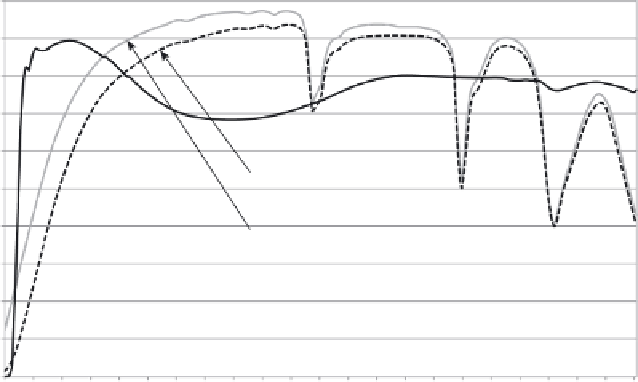Civil Engineering Reference
In-Depth Information
1. 0
0.9
0.8
0.7
Float glass, 6 mm
0.6
Direct transmittance
new sample, 14 mm
0.5
0.4
Total transmittance
new sample, 14 mm
0.3
0.2
Visible range
0.1
0.0
l
(nm)
10.9
Aerogel pane transmission optical properties: direct and total
solar spectral transmittance compared to a 6 mm thickness fl oat glass
(Buratti and Moretti, 2012b).
signifi cant absorption bands in the NIR transmission spectrum are shown
(
2500 nm) (Fig. 10.9). Further-
more, if only direct and total transmittance are compared, it could be
observed that a part of the radiation is scattered when transmitted through
the material, according to the Rayleigh scattering theory (Fig. 10.9, Buratti
and Moretti, 2012b). It causes reddening of the transmitted light, the bluish
appearance of the refl ected light and a possible blurred deformation of
optical images (Duer and Svendsen, 1998). A decrease in the optical quality
of the vision through the material is observed; nevertheless, this behaviour
could be preferred in some situations, because the light penetrates very
deeply in the room and it can reduce signifi cantly glare problems in façade
or skylight.
Using aerogel in clear windows can greatly affect the characteristics of
the incoming light, modifying the colour appearance of surfaces and objects
and contributing signifi cantly to the comfort and visual satisfaction of
human beings in indoor environments. The quality of the transmitted light
can be usefully represented by the general colour rendering index
R
a
, which
is calculated by applying the CIE standard procedure based on the differ-
ences in colour between eight test colours lighted directly by the reference
illuminant D65 and by the same illuminant after the transmission through
the glazing (EN 410, 2011); it is a normalized value in the 0-100 range. A
λ
≅
1350 nm;
λ
≅
1900 nm;
λ
≅
2200 nm;
λ
≅



Search WWH ::

Custom Search